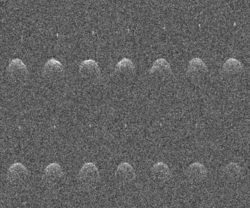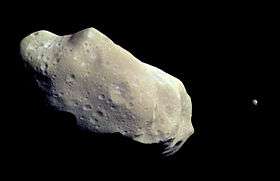Dimorphos
Dimorphos is a small asteroid satellite that was discovered in 2003. It is the minor-planet moon of a synchronous binary system with 65803 Didymos as the primary asteroid. After being provisionally designated as S/2003 (65803) 1 with informal nicknames such as "Didymos B" and "Didymoon", the Working Group Small Body Nomenclature (WGSBN) of the International Astronomical Union gave the satellite its official name on 23 June 2020.[3] At a diameter of 170 metres (560 ft), it is one of the smallest astronomical objects to have a permanent name.[2]
 Radar images of Didymos and its satellite Dimorphos by the Arecibo Observatory in 2003 | |
| Discovery[1] | |
|---|---|
| Discovered by | Petr Pravec et al.[lower-alpha 1] |
| Discovery date | 20 November 2003 |
| Designations | |
Designation | Didymos I |
Named after | Greek word for "having two forms"[2] |
| S/2003 (65803) 1 | |
| Orbital characteristics[1] | |
| 1.18±0.03 km | |
| Eccentricity | 0.06+0.06 −0.04 |
| 0.4958±0.0002 d | |
| Satellite of | 65803 Didymos |
| Physical characteristics[1] | |
Mean diameter | 0.170±0.030 km or 170±30 m |
| 11.8992±0.0048 h (if synchronous) | |
| 21.3±0.2 (difference from primary)[1] | |
Discovery
The primary asteroid was discovered in 1996 by Joe Montani of the Spacewatch Project at the University of Arizona. The name Didymos was officially approved in 2004.[1] Petr Pravec of the Ondřejov Observatory in the Czech Republic found in 2003 that the asteroid had a satellite orbiting it. With his collaborators, he confirmed from the Arecibo radar delay-Doppler images that Didymos is a binary system.[4]
Naming
The name is derived from a Greek word Dimorphos, meaning "having two forms".[5] The name was suggested by planetary scientist Kleomenis Tsiganis at the Aristotle University of Thessaloniki. The justification for the new name reads: "As the target of the DART and Hera space missions, it will become the first celestial body in cosmic history whose form was substantially changed as a result of human intervention (the DART impact)". Tsiganis further explained that the name "has been chosen in anticipation of its changes. It will be known to us in two very different forms, the one seen by DART before the impact, and the other seen by Hera a few years later".[2]
Characteristics

The primary body of binary system, Didymos, orbits the Sun at a distance of 1.0–2.3 AU once every 2 years and 1 month (770 days). The pathway of the orbit has an eccentricity of 0.38 and an inclination of 3° with respect to the ecliptic. It was known to be closest to Earth in November 2003 with a distance of 7.18 million km. It is expected to come around that near after 120 years.[6]
Dimorphos moves mostly in a circular retrograde orbit around Didymos,[7] with an orbital period of 11.9 hours around Didymos. It measures approximately 160 metres (520 ft) in diameter compared to 780 metres (2,560 ft) to that of Didymos.[8]
Exploration
NASA is planning to send a spacecraft Double Asteroid Redirection Test (DART) in July 2021. The spacecraft will crash-land on Dimorphos in September 2022. The collision is expected to bring the Dimorphos and Didymos closer to each other so that Dimorphos' orbits is shortened by 10 to 20 minutes. Then the European Space Agency will send its probe named Hera to Dimorphos in 2024 to study the new path of movement of the binary system.[3]
Notes
- Astronomers involved in the discovery include P. Pravec, L. A. M. Benner, M. C. Nolan, P. Kusnirak, D. Pray, J. D. Giorgini, R. F. Jurgens, S. J. Ostro, J.-L. Margot, C. Magri, A. Grauer, and S. Larson using lightcurve observations from Ondrejov Observatory, Czech Republic; Jet Propulsion Laboratory; National Astronomy and Ionosphere Center; Ondrejov Observatory, Czech Republic; Greene, Rhode Island, USA; University of California, Los Angeles, California, USA; University of Maine at Farmington, Maine, USA; University of Arkansas at Little Rock, Arkansas, USA; University of Arizona, Arizona, USA.[1]
References
- "(65803) Didymos". www.johnstonsarchive.net. Retrieved 2020-07-01.
- International Astronomical Union (23 June 2020). "IAU Approves Name of Target of First NASA and ESA Planetary Defence Missions". www.iau.org. Retrieved 2020-07-01.
- Temming, Maria (29 June 2020). "An asteroid's moon got a name so NASA can bump it off its course". ScienceNews. Retrieved 1 July 2020.
- Pravec, P.; Benner, L. a. M.; Nolan, M. C.; Kusnirak, P.; Pray, D.; Giorgini, J. D.; Jurgens, R. F.; Ostro, S. J.; Margot, J.-L.; Magri, C.; Grauer, A. (2003). "(65803) 1996 GT". IAUC. 8244: 2. Bibcode:2003IAUC.8244....2P.
- "MPEC 2020-M83 :". minorplanetcenter.net. Retrieved 2020-07-01.
- "JPL Small-Body Database Browser". ssd.jpl.nasa.gov. Retrieved 2020-07-01.
- Scheirich, P.; Pravec, P.; Jacobson, S.A.; Ďurech, J.; Kušnirák, P.; Hornoch, K.; Mottola, S.; Mommert, M.; Hellmich, S.; Pray, D.; Polishook, D.; Krugly, Yu.N.; Inasaridze, R.Ya.; Kvaratskhelia, O.I.; Ayvazian, V.; Slyusarev, I.; Pittichová, J.; Jehin, E.; Manfroid, J.; Gillon, M.; Galád, A.; Pollock, J.; Licandro, J.; Alí-Lagoa, V.; Brinsfield, J.; Molotov, I.E. (2015). "The binary near-Earth Asteroid (175706) 1996 FG3 — an observational constraint on its orbital evolution". Icarus. 245: 56–63. arXiv:1406.4677. Bibcode:2015Icar..245...56S. doi:10.1016/j.icarus.2014.09.023.
- "(65803) Didymos". www.johnstonsarchive.net. Retrieved 2020-07-01.

